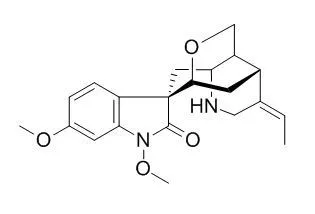| Kinase Assay: |
| J Ethnopharmacol. 2015 May 26;166:66-73. | | Inhibitory effects of cytochrome P450 enzymes CYP1A2, CYP2A6, CYP2E1 and CYP3A4 by extracts and alkaloids of Gelsemium elegans roots.[Pubmed: 25764964 ] | Gelsemium elegans (GE), widely distributed in East Asia, South East Asia and Northern America, is a kind of well-known toxic plant throughout the world. Yet it has been used as a Chinese folk medicine for treatment of malignant tumors, pain, rheumatic arthritis, psoriasis and immune function.
The present study was to investigate the potential inhibitory effects of G. elegans (GE) roots on four major cytochrome P450 (CYP450) isoforms (CYP1A2, CYP2A6, CYP2E1 and CYP3A4) in vitro.
METHODS AND RESULTS:
Four extracts (petroleum ether, dichloromethane, EtOAc and aqueous) of GE and two commercially available alkaloids (koumine and humantenmine) were screened for their CYP isoforms inhibitory activity. Four enzyme inhibition assays were examined according to the method of the literature. Phenacetin, coumarin, chlorzoxazone and testosterone were used as probe substrates in order to determine CYP1A2, CYP2A6, CYP2E1 and CYP3A4 catalytic activity, respectively. Each probe substrate was incubated with or without each extract and active constituent for corresponding isoform, followed by determination of the kinetics parameters, IC50 and Ki, to characterize inhibitory effects.
GE dichloromethane extract selectively inhibited activities of CYP2E1 (IC50=29.04µg/ml) and CYP2A6 (IC50=46.84µg/ml), with Ki of 10.16 and 19.33µg/ml, respectively. In the case of alkaloids, koumine exhibited significant inhibitory effects on CYP2E1 while humantenmine showed more potent inhibition on CYP2E1 and CYP2A6 (IC50 of 47.44, 18.34 and 45.87µg/ml, Ki of 31.20, 35.06 and 52.06µg/ml, respectively). Because of their relatively high Ki values, the active constituents in GE dichloromethane extract were analyzed. The UPLC-DAD-ESI-MS/MS data showed that GE dichloromethane extract contains 6 kinds of indole alkaloids (koumine, humantenmine, humantenine, Humantenirine, N-methoxytaberpsychine, and sempervirine). As for CYP1A2 and CYP3A4, the negligible inhibitions were observed.
CONCLUSIONS:
G. elegans extracts inhibited several CYP450 enzyme activities with varying potency. Strong inhibition was observed in CYP2E1 and CYP2A6 isoforms by GE dichloromethane extract, koumine and humantenmine, inferring the involvement of alkaloids chemical constituents from GE dichloromethane extract in the effect. |
|






 Cell. 2018 Jan 11;172(1-2):249-261.e12. doi: 10.1016/j.cell.2017.12.019.IF=36.216(2019)
Cell. 2018 Jan 11;172(1-2):249-261.e12. doi: 10.1016/j.cell.2017.12.019.IF=36.216(2019) Cell Metab. 2020 Mar 3;31(3):534-548.e5. doi: 10.1016/j.cmet.2020.01.002.IF=22.415(2019)
Cell Metab. 2020 Mar 3;31(3):534-548.e5. doi: 10.1016/j.cmet.2020.01.002.IF=22.415(2019) Mol Cell. 2017 Nov 16;68(4):673-685.e6. doi: 10.1016/j.molcel.2017.10.022.IF=14.548(2019)
Mol Cell. 2017 Nov 16;68(4):673-685.e6. doi: 10.1016/j.molcel.2017.10.022.IF=14.548(2019)